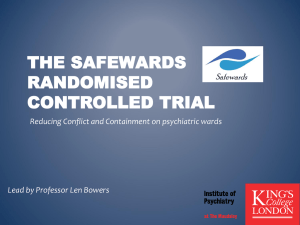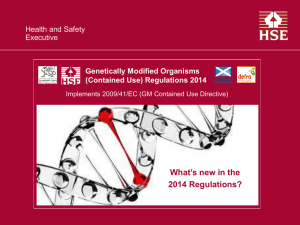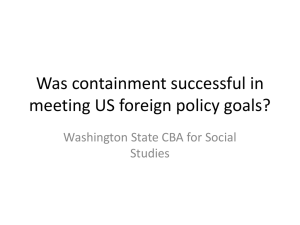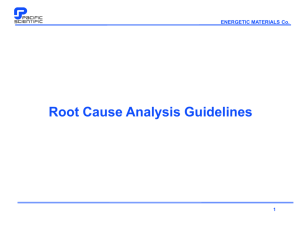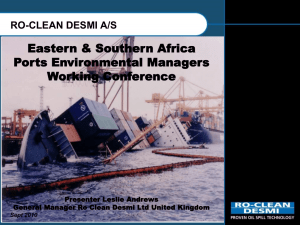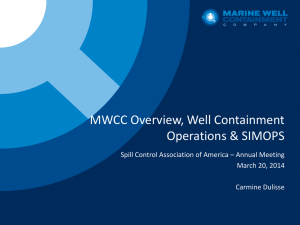HWCG - Energy
advertisement
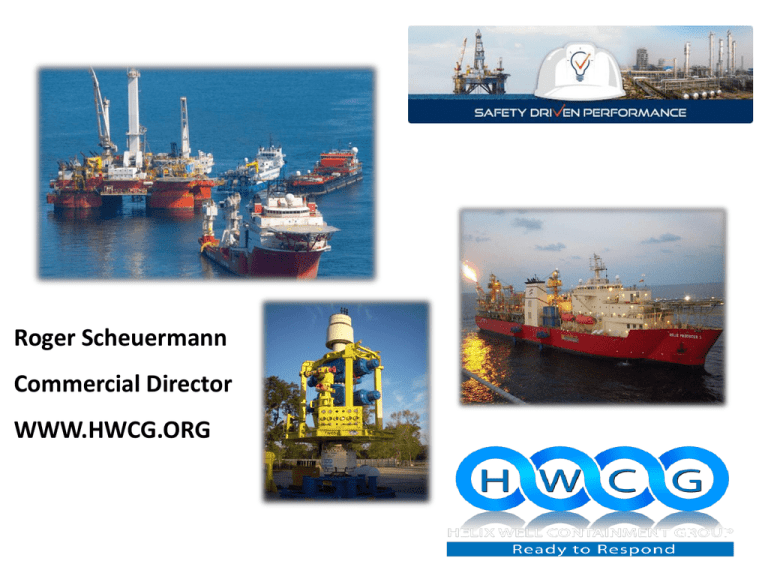
Roger Scheuermann Commercial Director WWW.HWCG.ORG BOEMRE - NTL No. 2010-N10 • Applies only to operators conducting operations using subsea blowout preventers (BOPs) or surface BOPs on floating facilities. • BSEE will be evaluating whether each operator has submitted adequate information demonstrating that it has access to and can deploy containment resources that would be adequate to promptly respond to a blowout or other loss of well control. BOEMRE – NTL 2010 – N10 • BSEE evaluation includes, but is not limited to the following: o Subsea containment and capture equipment, including containment domes and capping stacks o Subsea utility equipment, including hydraulic power, hydrate control and dispersant injection equipment o Riser systems o Remotely operated vehicles (ROVs) o Capture vessels o Support vessels o Storage facilities • BSEE will also evaluate whether there is adequate information identifying personnel who will be available to respond to a blowout or other loss of well control requiring the deployment of containment resources. Formation of HWCG • HWCG mission was to develop a comprehensive and rapid deepwater containment response system to meet NTL 2010N10 regulations. Members include 15 deepwater oil & gas companies that have access to specific equipment under agreements with Helix Energy Solutions Group and 30+ additional identified vendors. • Purpose was to develop an effective and timely response to a deepwater well containment incident in the Gulf of Mexico. Response time reduced from weeks to a few days depending on location of well, equipment and weather. • HWCG is not for profit company • HWCG core equipment under contract (HESG - Q4000, HP1) works on a daily basis to maintain and train personnel. HWCG Members ATP Oil & Gas Corporation Cobalt International Energy, LP Deep Gulf Energy, LP; Deep Gulf Energy II LLC ENI U.S. Operating Company Talos Energy - ERT GOM Inc. LLOG Exploration Company, LLC Marathon Oil Company 5 Marubeni Oil & Gas (USA), Inc. Murphy Exploration & Production Company - USA Noble Energy, Inc. Freeport McMoRan Oil & Gas Repsol E&P USA Inc. Stone Energy Walter Oil & Gas Corporation W&T Offshore HWCG "Model" “Fit-for Purpose” Response Protocols Well Containment Plan Tried and Tested Equipment /Purpose-built Collaboration Protocols Q4000 •DP3 MODU •US Flag – ABS classed •600 Ton Multi Purpose Tower (Derrick) •360 Ton / 160 Ton Deepwater Cranes •2 x 150 HP ROVs •3,000 barrel fluid handling system •Open deck versatile – intervention rig with moon pool •Seven (7) Knots transit speed FPU DP2 Helix Producer I • Process Capacity: • • • 45,000 BOPD 60,000 BLPD 80 MMCFD (can be expanded) • BSEE and USCG approved FPU with quick disconnect. Intervention Riser System (IRS) Package 10K Well Capping Stack Ingleside, TX 13 5/8” – 10K – Dual Ram 15K Capping stack Houston, Texas HWCG 18 ¾” full opening 15K psig double ram capping stack with 4 – 5” 15K side outlets HWCG Tophat HWCG - Helix Fast Response System 14 14 Level of Readiness – Immediate – Fast Response • HP 1 – Disconnect in 45 seconds • Q4000 – released when safe operations • Ability to capping wells with max shut-in pressure of 10K & 15K psi at water depths up to 10,000 ft. • Capture and flow back operations to Q4000 and HP1 up to 55,000 BOPD & 95 MMSCFD • Mutual Aid Agreement • Deepwater Intervention Technical Committee (DITC) member notification process in place for technical expertise for all members. Preparedness Exercises 16 Preparedness - Training • All HWCG members have signed a Mutual Aid Agreement that outlines the manner in which the 15 member companies will share technical experts and critical equipment during an event to a member. • HWCG held 60+ well containment exercises over the last 2 years. This test the Well Containment Plan and Mutual Aid. This includes hundreds of experts from member companies, contract vendors and agencies • Over 55 Permits approved with several in review – First permits (3), First floating facility - TPL/SPAR, First flow and capture permits. • Additional internal exercises continue to assure teams are prepared for the 6 primary position on the Source Control ICS organization chart. Focus on specific area training, and continue to learn and test the plan and work each area of responsibility. HWCG – Command Center • 15,000 square feet work area - Dedicated • Numerous hotels in area – 5 within 1 mile Command Center Location PetroSkills Conference Center 25403 Katy Mills Parkway Katy, Texas 77494 832 426 1200 Phone 832 426 1250 Fax 18 • Restaurants within walking distance • Shuttle parking • Audits – IT, Security, HS&E • 48 hour notice before move in. • Rentsys - displays ICS Organization Incident Commander Public Information Officer Liaison Officer Command Staff Safety Officer Source Control Section Chief 19 Operations Section Chief Planning Section Chief Logistics Section Chief Finance/Admin Section Chief General Staff Source Control ICS Organization Source Control Chief Deputy Source Control Relief Well Group Containment OPS Group Drilling Engineering Debris Removal Well Control Directional Drilling ROV Operations Utility IWOCS G&G - RP-Mutual Aid - RP/Vendors 20 SIMOPS Group Supply Vessel Pumping Flow Engr’s Group Chemical Flow Assurance Reservoir Engineering Anchor Handling Dispersant Intervention Vessel Flow Calculations Flowback Group Vessel Management Marketing Sales Well Containment Plan • The HWCG Deepwater Intervention Technical Committee (DITC) worked with BSEE staff in a concerted effort to develop a comprehensive Well Containment Plan (WCP) – Addresses the agency requirements in NTL 2010-N10. – BSEE approved HWCG RCD-Regional Containment Demonstration plan. • The WCP uses well established procedures and lessons learned from past incidents: – Comprehensive procedures and schedules addressing multiple well control scenarios (3) and responses – Pre-identified services and equipment – Comprehensive call out and “rapid response” activation protocols HWCG – IMH Incident Management Handbook for Source Control Actual visualization of specific operations Source Control follows the NIMS – ICS Planning P to stay in synch with Incident Management Team All roles and responsibilities are spelled out with description and checklist for ease understanding and operations. This show consistency between all members. Process of how Source Control would work with IMT/Unified Command in different locations. Well Containment Plan – Shut-in w/ Well Cap • • • • • • • • • Response Schedule, Equipment & Services Site Assessment & Initial Response Debris Removal LMRP or BOP Removal Well Cap Installation Well Shut-in Procedure Intervention Riser System (IRS) installation Well Kill & Abandonment Contingent “Flow & Capture” Operation 27 HWCG Incident Call-out Procedures 1-888-225-1721 Member (RP) calls 24-Hr Emergency Number Call 1-888-225-1721 Report is taken by ChemTel Drill or Incident Acronym RP Name Helix Well Containment Group HESG Helix Energy Solutions Group TEI Trendsetter Engineering, Inc. Send Word Now (Notification System) Personnel Equipment and/or Personnel Activation HESG Equipment only Responsible Party (Member) HWCG SWN HWCG will notify Group Leaders via SWN notification system ChemTel contacts HWCG HWCG calls DITC Chair and RP. Initial resources scoped. Conference HESG and/or Trendsetter. Personnel and Equipment will be activated based on the needs of the Responsible party HESG will make notifications to appropriate parties for deployment BSEE – HWCG Equipment Deployment • DOI is requiring HWCG to conduct a capping stack deployment operation in April/May 2013 to demonstrate the group’s ability to implement their response plan as outlined in their current approved generic Well Containment Plan (WCP). • The deployment plan outlined by BSEE indicates that source control was the focus area with the physical deployment and testing of the capping stack being the primary emphasis. • Exercise was initiated through the conventional BSEE unannounced drill program. • The HWCG DITC established a support team to work with the RP (Noble Energy) on planning and execution of the deployment. • Exercise initiated mobilization of full SMT which was stood down once it fulfilled the requirements set forth by BSEE during the exercise. • The HWCG mutual aid program activated to the extent necessary. • ICS implemented throughout the exercise, formal IAP developed. • 24-hour operation • 13 5/8” 10K capping stack deployment from Ingleside, TX location. • Excess of 5,000 feet water depth. • Test and function capping stack while on bottom. • Standard notifications of equipment and personnel will follow plan processes. – – – – Mutual Aid Vessels Dispersants Debris removal • Safety is priority one!!! 30 Key Strengths • Mutual Aid Agreement: Allows 15 deepwater companies to share resources (personnel and equipment) to withstand long-term events. Expertise in different areas of event. • Preparedness: Extensive training with numerous source control exercises which facilitates a learning environment. Well Containment Plan is a living document and will be updated as we achieve improved processes and procedures. • 30 + service providers bring expertise to exercises and event. • Core system equipment is maintained and operated daily in the GOM with experienced crews poised to respond. • Expansion plans are based on achievement of capacity growth by our members’ needs and requirements. Generic plan to be utilized by all members. • 10K and 15K capping stack – 18 ¾” full-bore, double ram intervention capping stack. • HWCG is ready to respond to any well containment event in U.S. GOM. HWCG GOM Subsea Oil Spill Control & Well Containment Roger Scheuermann 713-341-5000 roger@hwcg.org WWW.HWCG.ORG
